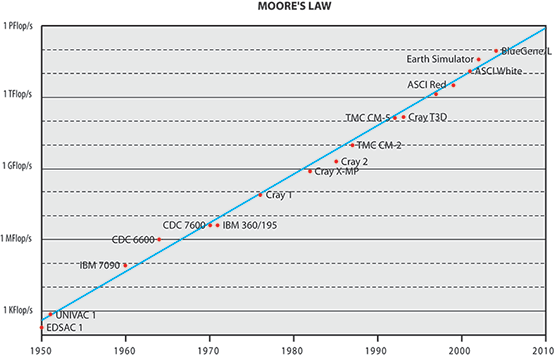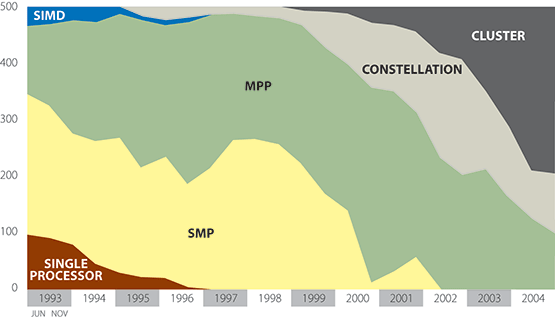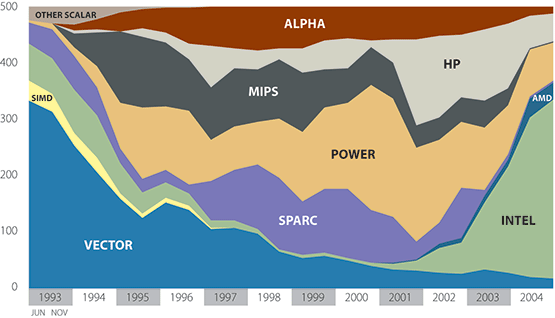
February 2005
|
Recent Trends in the Marketplace of High Performance Computing
|
 February 2005 |
"The Only Thing Constant Is Change" -- Looking back on the last four decades this seems certainly to be true for the market of High-Performance Computing systems (HPC). This market was always characterized by a rapid change of vendors, architectures, technologies and the usage of systems.1 Despite all these changes the evolution of performance on a large scale however seems to be a very steady and continuous process. Moore's Law is often cited in this context. If we plot the peak performance of various computers of the last six decades in Fig. 1, which could have been called the 'supercomputers' of their time,2,3 we indeed see how well this law holds for almost the complete lifespan of modern computing. On average we see an increase in performance of two magnitudes of order every decade.

At the end of the 1990s, clusters were common in academia but mostly as research objects and not primarily as general purpose computing platforms for applications. Most of these clusters were of comparable small scale and, as a result, the November 1999 edition of the TOP500 listed only seven cluster systems. This changed dramatically as industrial and commercial customers started deploying clusters as soon as applications with less stringent communication requirements permitted them to take advantage of the better price/performance ratio -roughly an order of magnitude- of commodity based clusters. At the same time, all major vendors in the HPC market started selling this type of cluster to their customer base. In November 2004 clusters were the dominant architectures in the TOP500 with 294 systems at all levels of performance (see Fig 2). Companies such as IBM and Hewlett-Packard sell the majority of these clusters and a large number of them are installed at commercial and industrial customers.

In addition, there still is generally a large difference in the usage of clusters and their more integrated counterparts; clusters are mostly used for capacity computing while the integrated machines primarily are used for capability computing. The largest supercomputers are used for capability or turnaround computing where the maximum processing power is applied to a single problem. The goal is to solve a larger problem or to solve a single problem in a shorter period of time. Capability computing enables the solution of problems that cannot otherwise be solved in a reasonable period of time (e.g., by moving from a 2D to a 3D simulation, using finer grids, or using more realistic models). Capability computing also enables the solution of problems with real-time constraints (e.g., predicting weather). The main figure of merit is time to solution. Smaller or cheaper systems are used for capacity computing, where smaller problems are solved. Capacity computing can be used to enable parametric studies or to explore design alternatives; it is often needed to prepare for more expensive runs on capability systems. Capacity systems will often run several jobs simultaneously. The main figure of merit is sustained performance per unit cost. Traditionally, vendors of large supercomputer systems have learned to provide for this first mode of operation as the precious resources of their systems were required to be used as effectively as possible. By contrast, Beowulf clusters are mostly operated through the Linux operating system (a small minority using Microsoft Windows) where these operating systems either lack the tools or these tools are relatively immature to use a cluster effectively for capability computing. However, as clusters become on average both larger and more stable, there is a trend to use them also as computational capability servers.
There are a number of choices of communication networks available in clusters. Of course 100 Mb/s Ethernet or Gigabit Ethernet is always possible, which is attractive for economic reasons, but has the drawback of a high latency (~ 100 μs). Alternatively, there are, for instance, networks that operate from user space, like Myrinet, Infiniband, and SCI. The network speeds as shown by these networks are more or less on par with some integrated parallel systems. So, possibly apart from the speed of the processors and of the software that is provided by the vendors of traditional integrated supercomputers, the distinction between clusters and this class of machines becomes rather small and will, without a doubt, decrease further in the coming years.
The HPC community had started to use commodity parts in large numbers in the 1990s already. MPPs and Constellations (Cluster of SMP) typically used standard workstation microprocessors even though they still might have used custom interconnect systems. There was however one big exception, virtually nobody used Intel microprocessors. Lack of performance and the limitations of a 32-bit processor design were the main reasons for this. This changed with the introduction of the Pentium III and especially in 2001 with the Pentium 4, which featured greatly improved memory performance due to its redesigned front-side bus and full 64-bit floating point support. The number of system in the TOP500 with Intel processors exploded from only 6 in November 2000 to 318 in November 2004 (Fig. 3).

Interest in novel computer architectures has always been great in the HPC community, which comes as little surprise as this field was born, and continues to thrive, on technological innovations. Some of the concerns of recent years were the ever increasing space and power requirements of modern commodity based supercomputers. In the BlueGene/L development, IBM addressed these issues by designing a very power and space efficient system. BlueGene/L uses not the latest commodity processors available but computationally less powerful and much more power efficient processor versions developed mainly not for the PC and workstation market but for embedded applications. Together with a drastic reduction of the available main memory this leads to a very dense system. To achieve the targeted extreme performance level an unprecedented number of these processors (up to 128,000) are combined using several specialized interconnects. There was and is considerable doubt whether such a system would be able to deliver the promised performance and would be usable as a general purpose system. First results of the current beta-System are very encouraging and the one-quarter size beta-System of the future LLNL system was able to claim the number one spot on the November 2004 TOP500 list.
Contrary to the progress in hardware development, there has been little progress, and perhaps regress, in making scalable systems easy to program. Software directions that were started in the early 1990’s (such as CM-Fortran and High-Performance Fortran) were largely abandoned. The payoff to finding better ways to program such systems and thus expand the domains in which these systems can be applied would appear to be large.
The move to distributed memory has forced changes in the programming paradigm of supercomputing. The high cost of processor-to-processor synchronization and communication requires new algorithms that minimize those operations. The structuring of an application for vectorization is seldom the best structure for parallelization on these systems. Moreover, despite some research successes in this area, without some guidance from the programmer, compilers are generally able neither to detect enough of the necessary parallelism nor to reduce sufficiently the inter-processor overheads. The use of distributed memory systems has led to the introduction of new programming models, particularly the message passing paradigm, as realized in MPI, and the use of parallel loops in shared memory subsystems, as supported by OpenMP. It also has forced significant reprogramming of libraries and applications to port onto the new architectures. Debuggers and performance tools for scalable systems have developed slowly, however, and even today most users consider the programming tools on parallel supercomputers to be inadequate.
All these issues prompted DARPA to start a program for High Productivity Computing Systems (HPCS) with the declared goal to develop a new computer architecture by the end of the decade with high performance and productivity. The performance goal is to install a system by 2009, which can sustain Petaflop/s performance level on real applications. This should be achieved by the combination of a new architecture designed to be easily programmable and combined with a complete new software infrastructure to make user productivity as high as possible.
Based on the current TOP500 data, which cover the last twelve years and the assumption that the current performance development continues for some time to come, we can now extrapolate the observed performance and compare these values with the goals of the mentioned government programs. In Fig. 4, we extrapolate the observed performance values using linear regression on the logarithmic scale. This means that we fit exponential growth to all levels of performance in the TOP500. This simple fitting of the data shows surprisingly consistent results. In 1999, based on a similar extrapolation,4 we expected to have the first 100 TFlop/s system by 2005. We also predicted that by 2005 no system smaller then 1 TFlop/s should be able to make the TOP500 any more. Both of these predictions are basically certain to be fulfilled next year. Looking out another five years to 2010 we expect to see the first PetaFlops system at about 20095 and our current extrapolation is still the same. This coincides with the declared goal of the DARPA HPCS program.

Looking even further into the future we could speculate that, based on the current doubling of performance every year, the first system exceeding 100 Petaflop/s should be available around or shortly after 2015. Due to the rapid changes in the technologies used in HPC systems there is however again no reasonable projection possible for the architecture of such a system in 10 years. The end of Moore's Law as we know it has often been predicted and one day it will come. New technologies, such as quantum computing that would allow us to further extend our computing capabilities are well beyond the capabilities of our simple performance projections. However, even as the HPC market has changed its face several times quite substantially since the introduction of the Cray 1 four decades ago, there is no end in sight for these rapid cycles of re-definition. And we still can say that in the High-Performance Computing market "The Only Thing Constant Is Change".